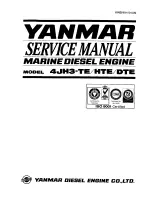
Operation
0710
−
1/A1
Winterthur Gas & Diesel Ltd.
Distillate fuels are used more in 2-stroke engines to meet area specified emission
standards. They are easier to operate than residual fuel, but caution is necessary for
some problems. See Service Bulletin RT
−
82: Distillate Fuel Use.
ISO 8217: 2010 specifies DMX, DMA, DMZ and DMB categories. The WinGD engine
inlet specification is based on the DMB grade which is the highest viscosity grade.
The DMX grade must not be bunkered as the viscosity could be below 2.0 mm
2
/s and
the flash point could be below 60
_
C.
5.
Data about Distillate Fuel Specifications
5.1
Viscosity
The recommended viscosity range on residual fuel upstream of the engine inlet is
13 mm
2
/
s
(cSt) to 17 mm
2
/
s
(cSt). But, because distillate fuel does not have such a
high viscosity, a minimum viscosity of 2.0 mm
2
/
s
(cSt) at the fuel pump inlet is
necessary.
Operators must be careful during the change-over procedure from distillate to residual
fuel and back to make sure of problem free operation. See the Service document:
Engine operation on MDO/MGO, change-over from HFO to MDO/MGO and the
Service Bulletin RT
−
82: Distillate Fuel Use.
In some conditions, it is possible that you cannot get the minimum viscosity of
2.0 mm
2
/
s
(cSt) at the fuel pump inlet. In such conditions, a fuel cooling system will be
necessary to make sure that the inlet to the fuel pumps has the minimum viscosity.
5.2
Density
The composition of the fuel gives the distillate density and a high density indicates a
high aromatic quantity.
5.3
Cetane Index
The ignition and combustion properties of a distillate fuel in a diesel engine is related
to the specific engine design, load profile and fuel properties. The Cetane Index is a
calculated quantity of the ignition properties or ignition interval of the fuel related to
the distillation and density. The density and the temperature when 10%, 50% and
90% of the fuel is distilled, gives the Cetane Index. This has no effect on the fuel
combustion properties.
5.4
Sulphur
Sulphur limits are specified in ISO 8217:2010 for distillate fuels, but statutory
specifications must be obeyed. The alkalinity (BN) of the cylinder lubricating oil must
be selected in relation to the sulphur content of the fuel in use.
The engine can operate for short periods (some hours) with a cylinder lubricating oil
that has an incorrect BN, but a longer operation time must be prevented.
Indications for the selection of the BN of lubricating oil in relation to the sulphur
content of the fuel are found in:
D
Running-in New Cylinder Liners and Piston Rings
D
.
5.5
Flash Point
The flash point is an important safety and fire hazard parameter for diesel fuels. Fuel
is always a fire hazard because there can be flammable vapors above the remaining
fuel in the tanks.
2017
−
08
Diesel Engine Fuels
Summary of Contents for W-X82
Page 10: ...Intentionally blank...
Page 14: ...Intentionally blank...
Page 18: ...Intentionally blank...
Page 28: ...Intentionally blank...
Page 34: ...Intentionally blank...
Page 38: ...Intentionally blank...
Page 44: ...Intentionally blank...
Page 52: ...Intentionally blank...
Page 58: ...Intentionally blank...
Page 60: ...Intentionally blank...
Page 62: ...Intentionally blank...
Page 68: ...Intentionally blank...
Page 70: ...Intentionally blank...
Page 76: ...Intentionally blank...
Page 78: ...Intentionally blank...
Page 86: ...Intentionally blank...
Page 92: ...Intentionally blank...
Page 94: ...Intentionally blank...
Page 96: ...Intentionally blank...
Page 100: ...Intentionally blank...
Page 104: ...Intentionally blank...
Page 108: ...Intentionally blank...
Page 112: ...Intentionally blank...
Page 114: ...Intentionally blank...
Page 116: ...Intentionally blank...
Page 138: ...Intentionally blank...
Page 140: ...Intentionally blank...
Page 142: ...Intentionally blank...
Page 144: ...Intentionally blank...
Page 146: ...Intentionally blank...
Page 150: ...Intentionally blank...
Page 154: ...Intentionally blank...
Page 172: ...Intentionally blank...
Page 174: ...Intentionally blank...
Page 208: ...Intentionally blank...
Page 210: ...Intentionally blank...
Page 250: ...Intentionally blank...
Page 252: ...Intentionally blank...
Page 254: ...Intentionally blank...
Page 258: ...Intentionally blank...
Page 262: ...Intentionally blank...
Page 272: ...Intentionally blank...
Page 282: ...Intentionally blank...
Page 286: ...Intentionally blank...
Page 294: ...Intentionally blank...
Page 310: ...Intentionally blank...
Page 332: ...Intentionally blank...
Page 334: ...Intentionally blank...
Page 337: ...Operation 4003 3 A1 Winterthur Gas Diesel Ltd 3 21 WCH00345 2014 Air Supply...
Page 340: ...Operation 4003 3 A1 Winterthur Gas Diesel Ltd 6 21 WCH01167 2014 Servo Oil Supply 9 cylinders...
Page 342: ...Operation 4003 3 A1 Winterthur Gas Diesel Ltd 8 21 WCH01123 2014 Fuel Supply 9 cylinders...
Page 343: ...Operation 4003 3 A1 Winterthur Gas Diesel Ltd 9 21 016 805 08 2014 Starting System...
Page 344: ...Operation 4003 3 A1 Winterthur Gas Diesel Ltd 10 21 016 335 07 2014 Speed Control...
Page 354: ...Operation 4003 3 A1 Winterthur Gas Diesel Ltd 20 21 018 138 09 2014 Cooling Water...
Page 356: ...Intentionally blank...
Page 360: ...Intentionally blank...
Page 366: ...Intentionally blank...
Page 372: ...Intentionally blank...
Page 376: ...Intentionally blank...
Page 380: ...Intentionally blank...
Page 386: ...Intentionally blank...
Page 390: ...Intentionally blank...
Page 400: ...Intentionally blank...
Page 404: ...Intentionally blank...
Page 408: ...Intentionally blank...
Page 416: ...Intentionally blank...
Page 422: ...Intentionally blank...
Page 442: ...Intentionally blank...
Page 450: ...Intentionally blank...
Page 452: ...Intentionally blank...
Page 478: ...Intentionally blank...
Page 484: ...Intentionally blank...
Page 510: ...Intentionally blank...
Page 516: ...Intentionally blank...
Page 520: ...Intentionally blank...
Page 522: ...Intentionally blank...
Page 526: ...Intentionally blank...
Page 542: ...Intentionally blank...
Page 546: ...Intentionally blank...
















































